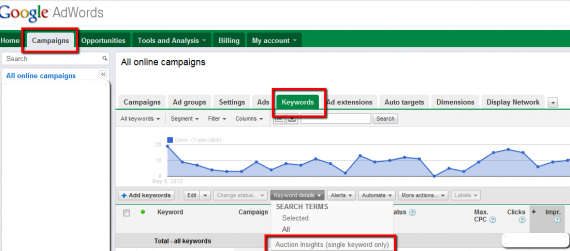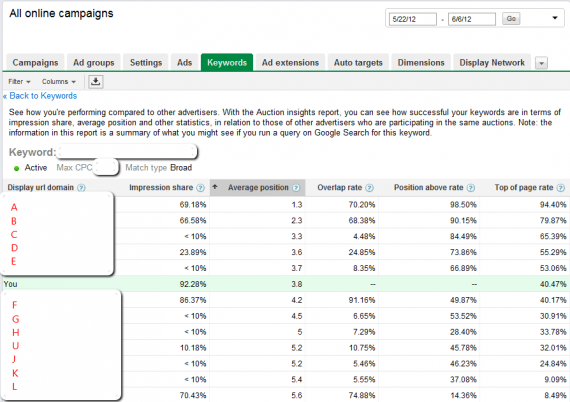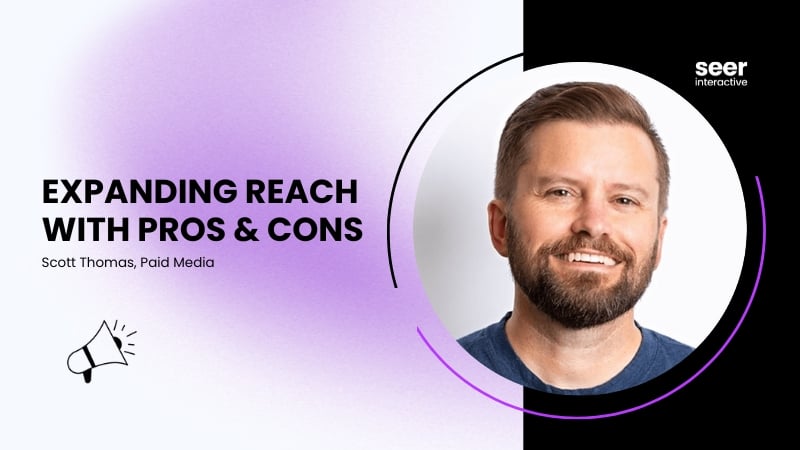AdWords came out with a new feature, Auction Insights, late last month. Auction Insights can be found in the campaigns section, keyword tab under the 'keyword details' subheading.

Auction Insights enables advertisers to see who else is bidding on a single keyword. Rimm Kaufman made a good point that this can get tricky if more than one keyword in an account could trigger a query, which is basically everyone who doesn't have an all exact match account. However, their rep assured them that there is 'no double counting of an impression opportunity' so the data can be used for analysis.
There is a plethora of ways to use Auction Insights. PPC Hero wrote a good blog on five ways to use Auction Insights and also speculated that Google might be replacing the need for SpyFu. In this blog, we’ll dive deep into one area Auction Insights can be used for - getting your bids and positions right for high volume terms based on your goals.
To identify an ideal bid/position, I’ll go through each statistic and give you the scoop on which statistics could be misleading. Knowing the minutiae of the Auction Insights statistic definitions is key to using Auction Insights correctly. We will use a sample auction (sorry, I’ve blocked out keywords, bids and competitors to keep this confidential) and how we can use this.
Google defines average position for auction insights as the average position for the participant’s ads when they received an impression (all successful auctions). Average position doesn't reflect the competitor’s position on the SERP's when you're also on the SERP's, but just the competitor’s position when they are successfully placed in an auction independent of you. This can actually vary substantially if impression share and overlap rate are low.

If you and the competitor have a very high overlap rate (how often another participant's ad received an impression when your ad also received an impression) it's unlikely that the competitor’s position on the SERP's when you are there will vary substantially because you're usually on the SERP's at the same time. If the overlap rate is lower, it could vary more. One can also look at impression share (How often a participant received an impression, as a proportion of the auctions in which you were also competing) to get at the same information (note they're very close to one another).
The best statistic to look at for the purpose of setting bids and managing average position is position above rate. Google defines position above rate as when you and another participant received an impression in the same auctions, how often the other participant’s ad was shown in a higher position on the page than yours was. Position above rate is better because it reflects when you're both there - apples to apples.
Looking at this auction, I see several things I need to know when making bid decisions and trying to reach a certain position
- Competitor F and my client are neck and neck. We're in about 90% of the same auctions (86% impressions share and 91% overlap rate) and when we're both there, it's 50/50 who'll be higher on the page (49.87% position above rate). If I lower my bids at all, competitor F could likely pull in front of me and reduce my volume substantially.
- Competitor G has a lower average position but is in a higher position than my client 54% of the time when we're both in the auction. This is possible because the overlap rate, average position and impression share statistics are calculated for all successful auctions, not the ones we're both in which is how position above rate is calculated.
- Competitor G is a potential threat. If they decide to increase their budgets or engage in the auction more often (we're overlapping less than 7% of the time) they could dislodge my client from their position (higher position above rate) more often. Currently, G only shows ahead of my client 3.49% of the time (0.5352*0.0665=0.0349) because they aren't in the auction very often (6.65% overlap rate). If they engage and overlap rate rises, G could cause problems for my client.
- Competitors U and J could also be threats if they chose to be. There position above rate is 46% despite much lower average position. Again, this is due to their low overlap rate with my client.
- Three of the competitors ahead of me (C, D and E) aren't in this auction that often (low impression share and overlap rates). It might look like, at first glance, since their average positions are only a bit higher I should raise bids to get ahead of them but they're not there that often to get ahead of due to a low overlap rate.
- Competitors A & B are well out ahead and out of reach. They're showing up higher than my client 90% and 98.5% of the time. I'd have to have substantially increase bids and/or have quality score improvements to increase my ad rank enough to pass them.
- The top of page rate (when a participant’s ad received impressions, how often it appeared at the top of the page above the search results) is telling for competitor A. Top of page rate is much like impression share, average position and overlap rate - it reflects the competitor’s data, not the competitor’s data when you're also in the auction. However, it's useful to know a competitor’s strategy. Competitor A is in top position over 94% of the time. So, their strategy might be to be in the top spot all the time, or they might be well beneath their CPA goal. In either case, even if I get to the top, I might have to go even higher with my bids in a bidding war.
Looking at this situation as a whole, I'm going to keep my bid where it's at or maybe increase it slightly. I'd have to raise bids a lot and/or improve quality score substantially to get the much higher ad rank needed to dislodge A or B and I'd risk a bidding war with A. Conversely, we're in tight competition with F and have some potential threats (U, J and G) we don't want to give a chance. If we don't protect ourselves by keeping our bids up, we could get knocked down a few positions on the SERP's.
The recommendation on what to do will vary by keyword auction. The mindset stays the same:
- Think about what you would get (click volume increases/decreases, CPC increases/decreases) from a bid increase/decrease and the corresponding average position increase/decrease.
- AdWords is a dynamic auction - think about what your competition might do. Does the data (possibly top of page rate) send warning signals about a potential bidding war?
The key thing to remember is that in Auction Insights, position above rate is the only unbiased statistic reflecting the auctions both you and your competitors are in. All of the other statistics are competitor data, independent of whether you're in the auction. For the purposes of setting bids to increase/decrease your volume, costs and position, use position above rate more.
What other ways are you using to analyzing Auction Insights?

